
Soviet Badge To The Best Urdanik Ukrainian SSR 1934
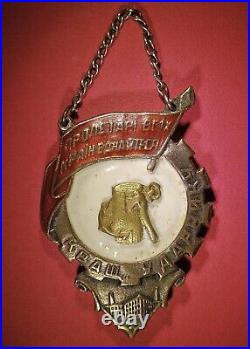
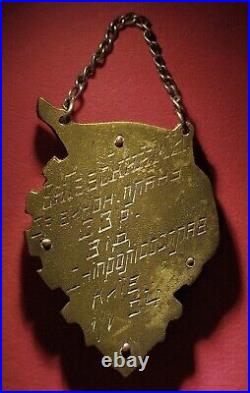









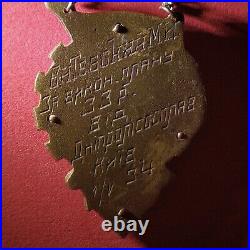









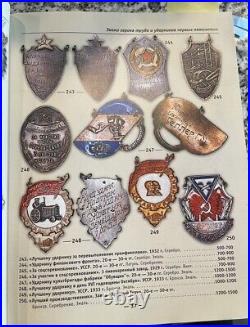
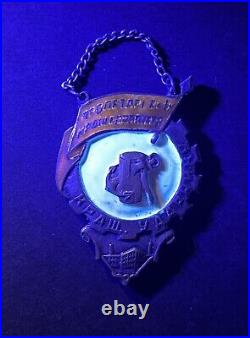

Soviet Badge “To The Best Urdanik” Ukrainian SSR 1934. Workers of the world, unite! “To the best shock worker”. (awarded to) Vitebsky M. For the completion of the plan in year 1933. From the Dniprosplav Factory, Kyiv. Height: 39.52 mm (middle banner to factory). Width: 30.22 mm. Weight: 17.424 g. Variants of these badges were awarded to the best shock workers at numerous Ukrainian factories and agricultural centers throughout the 1930’s following Stalin’s industrialization policy. Many depict the same overall styling of a banner and gear with a factory inset into the lower portion. All types (that I’m aware of) also share a common white enameled background with an image of the given trade of the worker super imposed over it. I was unable to find any particular information about this specific factory within Kyiv however I would imagine it had something to do with metallurgical production given the anchor and axe. The city (Kyiv) figured prominently in Stalin’s Five-Year Plans for industrialisation. In 1932, Dnipropetrovsk’s regional metallurgical plants produced 20 percent of the entire cast iron and 25 percent of the steel manufactured in the Ukrainian SSR. This badge is constructed of bronze and or brass and possibly tombac (various layers) with the obverse showing some silvering, as well as hot baked enamels. Similar examples can be seen in ABEPC #8 on pg 37, 248-249 (see attached image). Overall the condition is good for the age of this piece and an excellent design depicting the industrialization of the period. It shows very light wear on the silvering. Upon closer inspection this piece seems to have had someone re-enamel or touch up the original enamel (not entirely to the standards of the original production). However, this doesn’t detract from the piece when viewing with the naked eye. It is only apparent under a microscope or while viewing in UV light (pictured). The inscription on the reverse is consistent with known examples in content and engraving style. The engraving itself appears to have possibly the remnants of a cleaning creme or polishing paste. For the sake of not scratching the piece I did not attempt to clean it out. Although I don’t believe it would be too difficult to do with a sharp wood splinter of fine fiberglass pen brush. Lastly I believe the chain to be original to this piece. Let me know if you have any questions! 1930’s Kyiv History. In the 1930s, the city suffered terribly from famine and from Stalinization. In 1932-33, the city population, like most of the other Ukrainian territories, suffered from the Holodomor. In Kyiv, bread and other food products were distributed to workers by food cards according to daily norm, but even with cards, bread was in limited supply, and citizens were standing overnight in lines to obtain it. In 1934 the capital of Ukrainian SSR was moved from Kharkiv to Kyiv. The goal was to fashion a new proletariat utopia based on Stalin’s blueprints. The city’s architecture was made over, but a much greater impact on the population was Soviet social policy, which involved large-scale purges, coercion, and rapid movement toward totalitarianism in which dissent and non-communist organizations were not tolerated. In the 1930s the process of destruction of churches and monuments, which started in the 1920s, reached the most dramatic turn. Churches and structures that were hundreds of years old, such as St. Michael’s Golden-Domed Cathedral and the Fountain of Samson, were demolished. Others, such as Saint Sophia Cathedral, were confiscated. The city’s population continued to increase mostly by migrants. The migration changed the ethnic demographics of the city from the previous Russian-Ukrainian parity to predominantly Ukrainian, although Russian remained the dominant language. In the 1930s, the city inhabitants also suffered from the controversial Soviet political policy of that time. While encouraging lower-class Ukrainians to pursue careers and develop their culture (see Ukrainization), the Communist regime soon began harsh oppression of Ukraine’s political freedom, autonomy and religion. Recurring political trials were organized in the city to purge “Ukrainian nationalists”, “Western spies” and opponents of Joseph Stalin inside the Bolshevik party. During this time, numerous historic churches were destroyed or vandalized and the clergy repressed. In the late 1930s, clandestine mass executions began in Kyiv. Thousands of city residents (mostly intellectuals and party activists) were arrested in the night, hurriedly court-martialed, shot and buried in mass graves. The main execution sites were Babi Yar and the Bykivnia forest. Tens of thousands were sentenced to GULAG camps. In the same time, the city’s economy continued to grow, following Stalin’s industrialization policy. Reach out to me with any and all questions you have. All sales are final. Condition and authentication are “as seen”.
